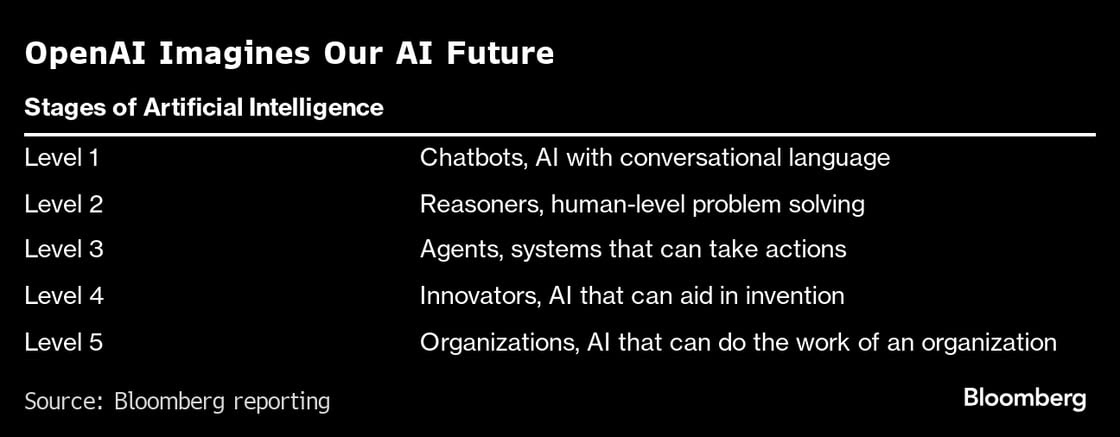The Future of AI? A Guide for Business Leaders

OpenAI has introduced a groundbreaking classification system to map its journey toward developing artificial intelligence (AI) systems that surpass human capabilities. This five-tier framework, designed to enhance transparency and public understanding of AI’s trajectory, offers a structured view of current achievements and future milestones. For senior business leaders, this system provides critical insights into where AI stands today and how it could reshape industries, operations, and innovation in the coming years.
CEO Sam Altman predicts AGI could emerge within this decade, driven by advancements in large language models (LLMs). However, Meta’s Yann LeCun argues AGI is a misnomer, asserting human intelligence itself is not truly “general.” Google DeepMind’s similar five-tier framework (including “expert” and “superhuman” stages) highlights a shared focus on benchmarking progress across the AI sector.
Open AI's 5 Levels of AI
Level 1: Conversational AI (Today’s Reality)
Current State: OpenAI confirms it is firmly at this stage.
Capabilities: AI systems like ChatGPT excel at natural language interactions, offering human-like text generation and coherent dialogue. These tools are already transforming customer service, content creation, and internal workflows.
Business Impact: Leaders should leverage these tools to automate routine communications, enhance productivity, and streamline decision-making processes.
Level 2: Reasoners (Near-Term Horizon)
Emerging Capabilities: AI at this level can solve complex, doctoral-level problems without external tools, demonstrating human-like reasoning. GPT-4 shows early signs of this ability.
Strategic Implications: Businesses can anticipate AI that tackles advanced analytical tasks, such as financial modeling or R&D problem-solving, reducing reliance on specialized human expertise.
Level 3: Autonomous Agents (Mid-Term Future)
Operational Shift: AI becomes proactive, executing multi-step tasks over days or weeks. Think of AI "employees" managing supply chains, HR workflows, or client onboarding autonomously.
Leadership Action: Prepare for workforce integration, ensuring ethical guardrails and governance frameworks are in place to manage AI-driven decision-making.
Level 4: Innovators (Long-Term Vision)
Transformational Potential: AI generates novel ideas, aiding scientific discovery, product design, and creative processes. This level could accelerate breakthroughs in pharmaceuticals, energy, or materials science.
Opportunity: Businesses must foster cultures that blend AI-driven innovation with human creativity to maintain competitive edges in fast-evolving markets.
Level 5: Organizational AI (AGI Frontier)
AGI Defined: AI operates at the scale of entire organizations, surpassing human performance in most tasks. This represents artificial general intelligence (AGI), a self-sufficient system capable of end-to-end management.
Strategic Imperative: While AGI remains theoretical, leaders must monitor its ethical, regulatory, and operational implications to avoid disruption and harness its potential responsibly.
Why This Matters for Business Leaders
-
Risk Mitigation: Understanding AI’s trajectory helps anticipate regulatory shifts, workforce disruptions, and ethical challenges.
-
Innovation Timing: Aligning R&D investments with AI’s maturation stages ensures businesses capitalize on breakthroughs (e.g., Level 4’s invention capabilities).
-
Competitive Readiness: Early adopters of Level 3 “Agents” will gain efficiency advantages, while laggards risk obsolescence.
Integrating the 5 AI Levels into your organisation
Foundation Building with Conversational AI (Level 1)
Leverage conversational AI tools like ChatGPT to automate customer interactions, internal documentation, and routine decision-making processes. Use these systems to enhance employee productivity through real-time data retrieval, meeting summarization, and standardized reporting. Establish governance frameworks to ensure ethical use and data security, while training teams to collaborate effectively with AI as a co-pilot for daily operations.
Track time saved in customer service, user satisfaction scores, and content accuracy in automated communications. Use KPIs like response time reduction, chatbot resolution rates, and human-AI collaboration efficiency. For example, measure how much faster marketing copy or reports are generated while maintaining brand consistency. Operational metrics like error rates in automated workflows and adoption rates across teams indicate practical success.
Augmenting Expertise with Reasoners (Level 2)
Prepare for AI systems capable of solving doctorate-level problems by integrating them into R&D, financial modeling, and risk assessment workflows. Use these tools to challenge human assumptions, validate hypotheses, and accelerate innovation cycles. Upskill employees to focus on creative problem-solving and oversight, ensuring human judgment remains central to high-stakes decisions while AI handles complex analytical heavy lifting.
Assess problem-solving accuracy against benchmarks (e.g., doctoral-level task completion rates) and decision-making speed for complex scenarios like financial modeling. Quantify cost savings from reduced expert dependency and innovation throughput (e.g., hypotheses tested per quarter). Use human-AI validation cycles to ensure outputs align with organizational goals, and track ROI from accelerated R&D or risk mitigation.
Operationalizing Autonomous Agents (Level 3)
Design processes for AI agents to manage multi-day tasks like supply chain optimization, talent acquisition, or compliance monitoring. Implement cross-functional teams to oversee AI-driven workflows, ensuring alignment with organizational values and regulatory requirements. Prioritize interoperability between human and AI roles, creating feedback loops to refine agent performance and accountability mechanisms.
Monitor task completion rates for multi-step workflows (e.g., supply chain optimization), operational cost reduction, and process scalability. Measure time-to-outcome for projects managed by AI agents and error escalation frequency. Use cross-functional alignment metrics to ensure AI-driven decisions adhere to compliance and ethical standards.
4. Driving Disruption with Innovators (Level 4)
Position your organization to harness AI-driven invention by fostering cultures that blend machine-generated insights with human creativity. Allocate resources to experimental projects where AI can propose novel product designs, market strategies, or operational models. Develop metrics to evaluate AI-generated ideas, balancing risk appetite with transformational potential to stay ahead in fast-evolving industries.
Evaluate patent filings, R&D cycle compression, and market differentiation from AI-generated ideas. Track creativity metrics (e.g., diversity of solutions proposed) and adoption rates of AI-driven innovations in product design or strategy. Measure ROI from accelerated time-to-market and stakeholder buy-in for AI-augmented ideation processes.
5. Preparing for Organizational AI (Level 5)
Anticipate AGI’s organizational-scale capabilities by stress-testing business models against scenarios where AI manages entire departments or subsidiaries. Invest in adaptive leadership training to navigate ethical dilemmas, workforce transitions, and regulatory landscapes shaped by self-sufficient AI systems. Collaborate with policymakers and industry peers to establish global standards for AGI governance, ensuring competitive resilience while mitigating existential risks.
Benchmark enterprise-wide efficiency gains, AGI-driven revenue streams, and competitive resilience against industry peers. Track regulatory compliance in self-managed AI systems and human workforce adaptation (e.g., reskilling rates). Use scenario-based stress tests to evaluate AGI’s decision-making robustness and long-term value creation in end-to-end organizational management.
Best Practices for Continuous AI Model Assessment and Improvement
To maintain AI models’ accuracy, relevance, and fairness, businesses must adopt iterative evaluation and enhancement strategies. As AI systems evolve and real-world data shifts, continuous monitoring and refinement ensure they deliver reliable, actionable insights while minimizing risks like bias or performance decay. Below are key practices for sustaining AI excellence:
Performance Metrics and Prioritize Data Quality
Track task-specific KPIs (e.g., precision, recall, F1 scores for classification; RMSE for regression) alongside business outcomes like cost savings or customer retention. Regularly update benchmarks to reflect changing operational goals and market conditions. Curate datasets that mirror real-world scenarios, addressing gaps in representation to reduce bias. Continuously enrich data with new, high-quality samples and refine labeling practices to improve model generalization across edge cases.
Adopt Hybrid Evaluation Frameworks
Combine automated tools (e.g., confusion matrices, calibration curves) with human-in-the-loop reviews to assess both technical performance and contextual relevance. For generative AI, integrate domain-specific quality checks (e.g., factual accuracy in healthcare, creativity in marketing). Leverage techniques like Bayesian optimization or grid search to fine-tune model architectures. Retrain models on updated datasets to adapt to concept drift, ensuring they remain aligned with current data patterns.
Embed Explainability and Governance
Use interpretability tools (e.g., SHAP, LIME) to audit decision logic, particularly for high-stakes applications. Establish governance protocols to monitor ethical compliance, regulatory adherence, and alignment with organizational values.
Foster Continuous Feedback Loops and Modular Iteration
Integrate real-time user feedback and automated monitoring systems to detect performance degradation. Regularly stress-test models against emerging edge cases and evolving threats (e.g., adversarial attacks). Decouple model components to enable incremental updates without full redeployment. This approach minimizes downtime while allowing rapid integration of new data sources or algorithmic advancements.
In closing
OpenAI plans to refine this framework through feedback from employees, investors, and its board, ensuring it evolves alongside technological advancements. For businesses, staying informed and adaptable is non-negotiable—AI’s progression will redefine what’s possible, and leaders must act now to shape its role in their organizations. OpenAI’s framework isn’t just a roadmap for researchers; it’s a strategic lens through which forward-thinking leaders can future-proof their operations, teams, and visions.


